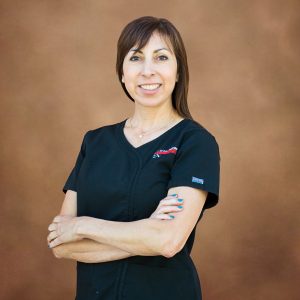Las Cruces Comprehensive Rehabilitation offers something that is difficult to find anywhere else in the area: prosthetic training for those requiring a hand and arm prosthesis. Laura Visanko, M.O.T. is an occupational therapist that has been working with hands for 29 years and has received specialized training on working with patients that will be receiving a hand prosthesis. Visanko begins working with patients before they ever receive the prosthesis, helping file insurance paperwork and provide justification for the device, which can be a lengthy and complicated process. Visanko coordinates with the doctor and prosthesis supplier, such as Hanger or PrimeCare. In conjunction with all of this, patients also begin occupational therapy with Visanko that will support their use of the prosthesis once it is received. She works with and supports her patients every step of the way!
 According to the National Center for Biotechnical Information, “majority of all upper-limb amputations are the result of trauma,” but “other common causes of upper-limb loss are vascular/infection, congenital absence, and cancer.” While not using a prosthetic device is an option, patients often find it much easier to rejoin a bi-manual world with the use of some sort of prosthetic device.
According to the National Center for Biotechnical Information, “majority of all upper-limb amputations are the result of trauma,” but “other common causes of upper-limb loss are vascular/infection, congenital absence, and cancer.” While not using a prosthetic device is an option, patients often find it much easier to rejoin a bi-manual world with the use of some sort of prosthetic device.
There are several different types of prosthetic devices that can be used in the case of upper-limb loss. One of these devices is the passive prosthesis. The passive prosthesis is mostly used for the appearance. As passive prosthesis can closely resemble the patient’s sound arm. It does not move on its own, but can be used to restore some balance and for stabilizing and carrying objects. Passive prostheses are often used if the patient does not have significant muscle left in the arm. It is also the lightest option and therefore may be more comfortable. It requires manual repositioning, usually through the use of the sound hand.
Another type of prosthesis is the myoelectric prosthesis, such as the iLimb. Myoelectric prostheses are body-powered, meaning that the movement of the device is connected to a body part. Electrodes are used from the bicep or tricep to activate the myoelectric hand. A myoelectric hand is multi-articulating and each digit is individually powered. In order to use a myoelectric prosthesis, patients must have some muscle tissue left in their remaining arm in order to activate the myoelectric hand. Some of the benefits of the myoelectric prosthesis are that it has multiple grip patterns and effortless strength. It can also be the most intuitive and physiologically natural option. In addition, it can be covered with silicone that can closely resemble a patient’s natural skin.
Patients are first assessed to determine what kind of prosthetic device would be best for their particular situation. At this initial evaluation, their strength of remaining muscles is assessed, as well as their range of motion. Patients with a strength grade of at least 3-4 may qualify for a myoelectric prosthesis. Those with little to no muscle left in their arm will likely be fitted with a passive prosthesis.
Before the patient even receives their prosthesis, Visanko works with them both physically and mentally preparing them for it. She says it’s important for the patient to work on the mindset of returning to a bi-manual world. She talks to them about their activities of daily living (ADL) and any adaptive equipment they may need in order to perform these daily tasks, such as dressing, cooking, chores, driving and even creative activities they enjoy, such as painting or drawing. In addition, the exercises they do creates endorphins, which can help relieve pain, reduce stress and help the patient’s overall wellness.
The patient must also be prepared physically. They work on core strength and posture, as well as scapular stabilization. Visanko works with patients on restoring range of motion and neuromuscular strength using light resistance. Patients must also be prepared to strengthen the distal site, in order to carry the weight of the prosthesis. Weights are used on the distal site in order to prepare the patient for this. In addition, Visanko addresses issues such as scar tissue, hypersensitivity, swelling and phantom pain, where the patient still feels the pain of the lost extremity. One of the therapies she uses to address this is mirror visual feedback.
When the patient finally gets their prosthesis, Visanko helps them get comfortable with it, learn to don it themselves and of course, learn how to use it in everyday life. In the case of a myoelectric prosthesis, the patient first learns to open and close it. Then they learn prehension patterns, such as lateral pinch and tripod pinch, which is used for picking things up. Finally they learn to program certain positions that they know they will use often. Lastly, the patient transitions from programming into function, by using the prosthesis for everyday tasks, such as pulling up their pants, holding jars, cutting vegetables, etc…as well as creative activities or work they once engaged in. It is in this final transition that patients are able to find freedom in returning to the bi-manual world and the activities and work they once enjoyed.
Patients with limb loss can find additional support from organizations such as the Amputee Coalition and the Amputation Foundation. They can also find additional resources at the National Limb Loss Information Center. For more information about prosthetic training or working with Laura Visanko, contact Las Cruces Comprehensive Rehabilitation at (575) 522-0484.
